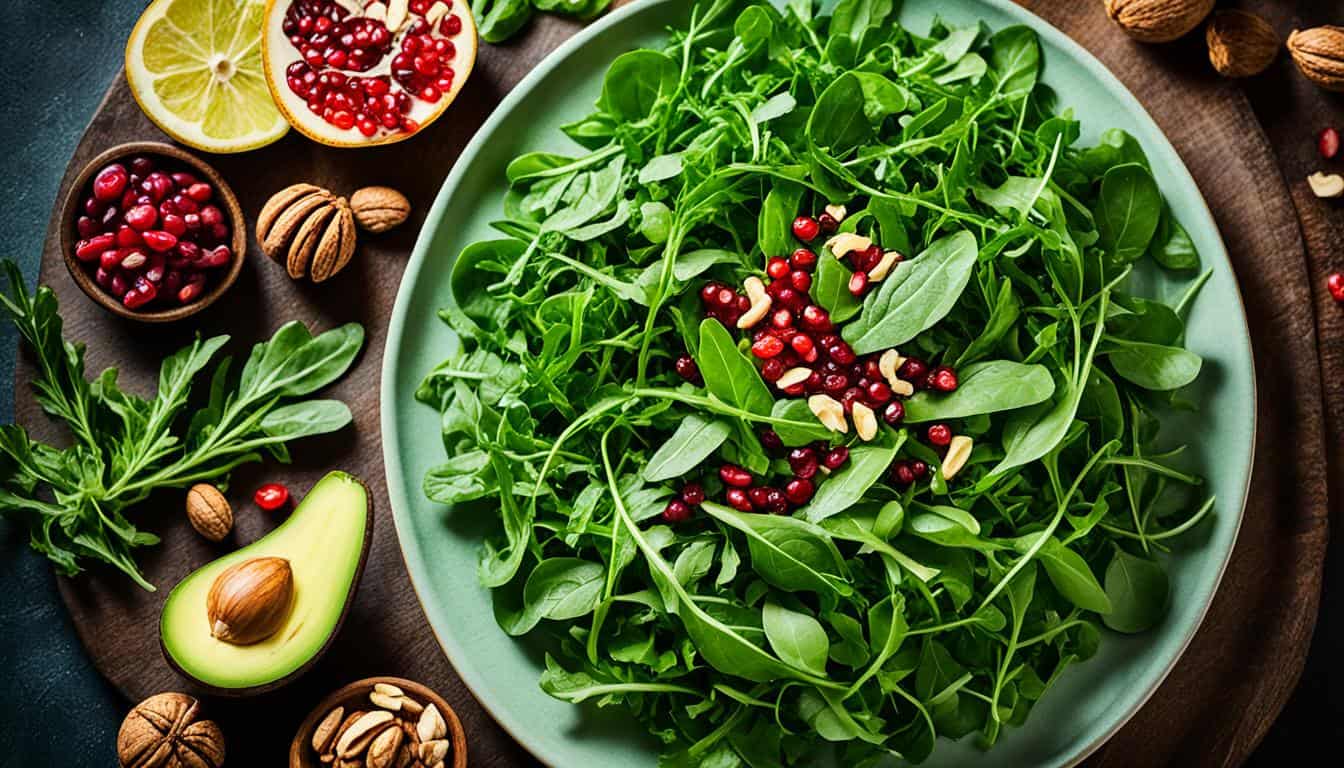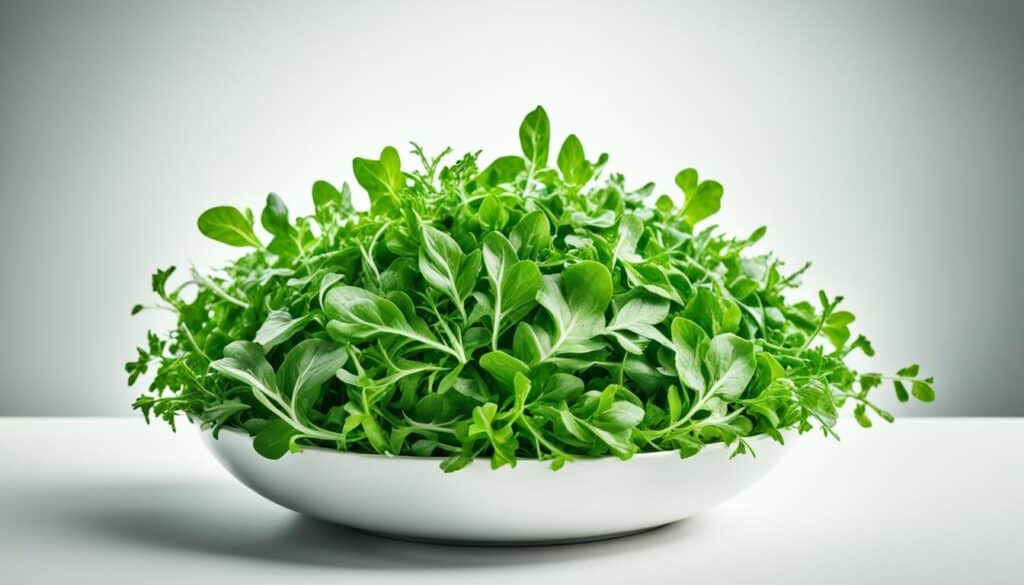Did you know that arugula leaves are not just a delicious addition to your salads, but they are also packed with numerous health benefits? It’s true! Arugula is a nutrient-dense food that is low in calories and fats, making it an excellent choice for those looking to eat healthy. But that’s not all—arugula has been linked to a reduced risk of cancer and heart disease. Plus, it’s composed of 90% water, making it a hydrating food option.
So, if you’re eager to learn more about the fresh and zesty world of arugula, keep reading! In this comprehensive guide, I’ll delve into the nutritional highlights, health powers, buyer’s guide, fresh cooking ideas, and even compare the flavor profile of arugula with other greens.
Key Takeaways:
- Arugula leaves are not only delicious but also packed with numerous health benefits.
- They are a nutrient-dense food, low in calories and fats.
- Regularly consuming arugula has been linked to a reduced risk of cancer and heart disease.
- Arugula is composed of 90% water, making it a hydrating food option.
- This guide will explore the nutritional highlights, health powers, buyer’s guide, fresh cooking ideas, and flavor profile of arugula.
Arugula Nutrition Highlights
Arugula is a nutrient powerhouse, offering a wide range of health benefits. Let’s explore the nutritional benefits of arugula:
1. Vitamin A
Arugula is high in vitamin A, which plays a crucial role in supporting the immune system, maintaining heart health, and preserving good vision. Vitamin A is also an essential nutrient for healthy skin and mucous membranes.
2. Potassium
Arugula provides a good source of potassium, a mineral that helps support healthy blood pressure levels. Potassium plays a vital role in maintaining proper fluid balance, supporting nerve and muscle function, and promoting heart health.
3. Calcium
Arugula is rich in calcium, which is essential for maintaining strong bones and teeth. It also plays a crucial role in muscle function and aids in blood clotting. Incorporating arugula into your diet can be an excellent way to boost your daily calcium intake.
4. Iron
Iron is an essential mineral for carrying oxygen throughout the body and supporting energy production. Arugula offers a good source of iron, making it a great choice for individuals looking to increase their iron levels, especially for those following vegetarian or vegan diets.
5. Magnesium
Arugula is also a good source of magnesium, a mineral that plays a vital role in various bodily functions. Magnesium is involved in energy production, protein synthesis, muscle and nerve function, and maintaining a healthy immune system.
6. Folate
Folate, also known as vitamin B9, is essential for DNA synthesis and cell division. Arugula provides a significant amount of folate, which is especially important for pregnant women as it supports fetal development and reduces the risk of certain birth defects.
By incorporating arugula into your diet, you can enjoy these nutritional benefits and support your overall health and well-being.
| Nutrient | Amount per 100g |
|---|---|
| Vitamin A | 1488 IU |
| Potassium | 369 mg |
| Calcium | 160 mg |
| Iron | 1.46 mg |
| Magnesium | 47 mg |
| Folate | 97 μg |
Arugula Health Powers
Arugula, with its bold and peppery flavor, not only adds a zesty kick to meals but also offers incredible health benefits. This leafy green is packed with powerful compounds called glucosinolates, which have been linked to reducing the risk of various types of cancer. Regularly consuming arugula can contribute to the prevention of lung, breast, prostate, stomach, and colon cancers.
Additionally, arugula is rich in flavonoids, which are potent antioxidants. These compounds have been studied for their potential to reduce the risk of heart disease, autoimmune conditions, and various types of cancer. Including arugula in your diet can support overall wellness and provide protection against these serious health conditions.
Arugula Health Benefits at a Glance:
| Health Benefit | Description |
|---|---|
| Reduced Cancer Risk | Regular consumption of arugula and its glucosinolates has been associated with a decreased risk of lung, breast, prostate, stomach, and colon cancers. |
| Disease Prevention | The flavonoids present in arugula have shown promise in reducing the risk of heart disease, autoimmune conditions, and cancer. |
Arugula’s health powers make it a wonderful addition to any diet. Harness the benefits of this green powerhouse by incorporating it into your meals and enjoy its unique flavor while supporting your overall well-being.
Buyer’s Guide
When it comes to purchasing arugula, you have a few options. Arugula is readily available in most grocery stores year-round, but for the freshest arugula, spring and fall are the best seasons to find it. Additionally, you can take matters into your own hands and grow your own arugula in a garden bed or pot, which is a rewarding experience.
Growing arugula is relatively simple and doesn’t require much time. It sprouts easily from seed and can be harvested in as little as a month. By growing your own arugula, you can have a constant supply of this flavorful leafy green.
When shopping for arugula, keep an eye out for certain qualities. Look for firm, dark green leaves, which indicate freshness. Avoid arugula that has yellow or wilted leaves, or dried and brown tips. These are signs that the arugula is not at its best.
After purchasing arugula, it’s important to store it properly to maintain its freshness. Arugula should be stored in the lowest humidity section of the refrigerator. Additionally, keep the leaves dry to prevent them from becoming soggy or wilting prematurely. By following these storage guidelines, you can extend the shelf life of your arugula and enjoy it for longer.
If you prefer organic produce, look for certified organic arugula. Organic arugula is grown without the use of synthetic pesticides, fertilizers, or genetically modified organisms (GMOs). Choosing organic arugula ensures that you’re consuming a product that has been grown in a more sustainable and environmentally friendly manner.
Whether you choose to purchase arugula from the store or grow your own, the key is to select fresh, high-quality leaves. This ensures that you’re getting the best flavor and nutritional benefits from this delicious and healthful green.
Fresh Ideas for Cooking Arugula
If you’re looking to add a fresh and zesty twist to your meals, arugula is the perfect ingredient to incorporate into your cooking. With its peppery taste, arugula adds a burst of flavor to various dishes, making it a versatile option in the kitchen.
Here are some creative ways to use arugula in your recipes:
- Arugula Salad: Create a vibrant and nutritious salad by mixing arugula with other fresh greens, cherry tomatoes, cucumber slices, and a tangy vinaigrette dressing. The combination of flavors and textures will delight your taste buds.
- Arugula Sandwich: Layer arugula on your favorite sandwich to add a refreshing crunch. Try pairing it with roasted turkey, sliced avocado, and a smear of Dijon mustard for a satisfying lunch option.
- Arugula Wrap: Wrap up arugula with grilled chicken, feta cheese, and roasted red peppers in a whole wheat tortilla for a tasty and portable meal.
- Arugula Pizza: Sprinkle arugula on top of your homemade or store-bought pizza for an added pop of flavor. The slight bitterness of the arugula complements the richness of the cheese and the savory toppings.
For those who enjoy refreshing smoothies, arugula can also be a surprising addition. Blend it with fruits like pineapple, mango, and banana for a nutrient-packed boost.
Note: Arugula can wilt easily, so make sure to add it to your dishes just before serving to preserve its freshness and texture.
The Versatility of Arugula: From Pesto to Omelets
Arugula can be used in various other recipes to take advantage of its distinct flavor profile and nutritional benefits. Here are a few more ideas:
- Replace some or all of the parsley with arugula in homemade pesto to add a peppery kick.
- Add arugula to omelets, soups, and stews to enjoy its flavor and reap its nutritional benefits.
Although arugula loses its shape when cooked, it still imparts its unique taste, making it a versatile ingredient in both raw and cooked dishes.
| Recipe | Description |
|---|---|
| Arugula Salad with Lemon Vinaigrette | A refreshing salad featuring arugula, cherry tomatoes, red onion, and a tangy lemon vinaigrette. |
| Arugula Pesto Pasta | A flavorful pasta dish where arugula replaces traditional basil in a homemade pesto sauce. |
| Grilled Chicken and Arugula Wrap | A delicious wrap filled with grilled chicken, arugula, sun-dried tomatoes, and a creamy yogurt dressing. |
| Arugula and Feta Pizza | A homemade pizza topped with arugula, feta cheese, Kalamata olives, and a drizzle of balsamic glaze. |
These recipes are just a starting point. Feel free to experiment with arugula in your favorite dishes to discover new and delicious flavor combinations.
Arugula Flavor Profile and Comparison
Arugula has a distinctive flavor profile that sets it apart from other leafy greens. Its taste is best described as peppery, spicy, and slightly nutty, adding a vibrant kick to any dish. To balance its bold flavor, arugula is often mixed with milder salad greens like spinach or lettuce.
When comparing arugula to spinach, there are notable differences in flavor. While spinach has a mild and slightly sweet taste, arugula leans towards the bitter side. These contrasting flavors lend themselves to different culinary applications.
“Arugula’s peppery bite adds a delicious zing to salads and dishes, creating a unique taste experience.”
Despite arugula’s more assertive flavor, it offers its own set of health benefits. While spinach may boast a higher nutrient profile, arugula is still a nutritional powerhouse, packed with vitamins and minerals.
Arugula Flavor Profile
Arugula’s distinctive flavor profile comes from its high content of compounds called glucosinolates. These compounds are responsible for the peppery and slightly bitter taste that arugula is known for.
Arugula also contains flavonoids, which contribute to its complex flavor. The combination of these compounds gives arugula a unique and memorable taste.
Arugula vs. Spinach
When comparing arugula and spinach, flavor preference often comes down to personal taste. While spinach has a milder and sweeter flavor, arugula’s bold and peppery taste adds a flavorful punch to dishes.
Here is a comparison of the flavor profiles of arugula and spinach:
| Arugula | Spinach |
|---|---|
| Peppery | Mild |
| Spicy | Slightly sweet |
| Slightly nutty | – |
| Bitter | – |
Although arugula may be less sweet than spinach, it offers a unique flavor profile that can enhance the taste of various dishes.
Arugula and Its Nutrition
Arugula is a nutritional powerhouse, packed with essential vitamins and minerals that promote overall health and well-being. This leafy green is not only delicious but also offers a range of health benefits that make it a valuable addition to any diet.
One of the key nutritional highlights of arugula is its rich folate content. Folate is an important nutrient that supports cell growth and development, making it particularly crucial during pregnancy. Arugula is also a good source of calcium, which is essential for strong bones and teeth.
Additionally, arugula is loaded with vitamins C, K, and A, which play vital roles in supporting the immune system, promoting blood flow, and maintaining healthy vision. These vitamins also act as antioxidants, protecting the body against oxidative stress and free radicals.
Furthermore, arugula contains potassium—a mineral that helps regulate blood pressure and maintain proper heart and muscle function. Potassium also aids in balancing fluids and electrolytes in the body.
Regularly consuming arugula provides a range of health benefits. The following table highlights the nutritional composition of arugula:
| Nutrient | Amount per 100g |
|---|---|
| Calories | 25 |
| Protein | 2.6g |
| Carbohydrates | 3.6g |
| Fat | 0.7g |
| Fiber | 1.6g |
| Vitamin A | 2373 IU |
| Vitamin C | 15mg |
| Vitamin K | 108.6mcg |
| Calcium | 160mg |
| Potassium | 369mg |
Arugula’s nutrient profile makes it an excellent choice for individuals looking to maintain a healthy diet. Incorporating arugula into your meals can help reduce the risk of chronic diseases, improve bone health, regulate glucose levels, and promote heart health.
Storing and Substituting Arugula
If you want to keep your arugula fresh for longer, proper storage is key. Here are some tips on how to store arugula to maintain its freshness:
- Loose arugula leaves should be wrapped in paper towels to absorb excess moisture.
- Place the wrapped arugula in a plastic bag, removing as much air as possible before sealing it.
- Store the bagged arugula in the refrigerator’s vegetable compartment or the lowest humidity section.
By following these storage guidelines, you can enjoy your arugula for up to five days without it wilting or losing its freshness.
Arugula Substitutes
If you can’t find arugula or simply want to try something different, several greens can be used as substitutes. Here are some options:
- Watercress: This leafy green has a similar peppery taste as arugula, making it a suitable substitute in salads or sandwiches.
- Dandelion greens: With a slightly bitter flavor, dandelion greens can be used as a substitute in salads or sautéed dishes.
- Mixed greens: A mix of different lettuces and greens can provide a similar texture and freshness as arugula.
- Baby spinach: While sweeter than arugula, baby spinach can still add a touch of green freshness to your dishes.
- Baby kale: Baby kale has a milder taste than mature kale and can be used as a substitute in salads or cooked dishes.
Experimenting with these arugula substitutes can add variety and new flavors to your recipes while still reaping the nutritional benefits.
Comparison Table: Arugula vs. Arugula Substitutes
| Arugula | Watercress | Dandelion Greens | Mixed Greens | Baby Spinach | Baby Kale | |
|---|---|---|---|---|---|---|
| Taste | Peppery, slightly nutty | Peppery | Bitter, slightly earthy | Varies (depending on the mix) | Mild, slightly sweet | Mild, slightly earthy |
| Texture | Tender | Tender | Tender | Tender | Tender | Tender |
| Nutritional Content | Rich in vitamins A, C, K, calcium, iron, and potassium | Rich in vitamins A, C, K, and calcium | Rich in vitamins A, C, K, calcium, iron, and antioxidants | Varies (depending on the mix) | Rich in vitamins A, C, K, iron, and potassium | Rich in vitamins A, C, K, calcium, and iron |
While arugula has its distinctive taste and nutritional profile, these substitutes can liven up your meals and provide a similar culinary experience.
Benefits of Arugula in Your Diet
Incorporating arugula into your diet offers numerous health benefits. Arugula, rich in sulforaphane, a substance found in cruciferous vegetables, can help reduce the risk of cancer. It also supports bone health, regulates glucose levels, and promotes heart health. Adding arugula to your meals provides a variety of essential nutrients and contributes to overall well-being.
Arugula’s health benefits stem from its impressive nutritional profile. Let’s take a closer look at some of the key nutrients found in arugula:
| Nutrient | Health Benefit |
|---|---|
| Vitamin A | Supports immune function and healthy vision |
| Calcium | Plays a vital role in bone health and metabolism |
| Vitamin C | Acts as an antioxidant, supports collagen production, and enhances iron absorption |
| Vitamin K | Essential for blood clotting and bone health |
| Potassium | Helps maintain healthy blood pressure levels and supports proper muscle and nerve function |
| Folate | Plays a crucial role in cell growth and development, particularly during pregnancy |
In addition to these nutrients, arugula is also a good source of iron, magnesium, and antioxidants.
Not only does arugula provide a wide range of essential nutrients, but it is also low in calories and fats, making it an excellent choice for those seeking a healthy and balanced diet. Its peppery flavor adds a zesty touch to various dishes, making it a versatile and flavorful addition to salads, sandwiches, pasta, and more.
Give this refreshing Arugula and Watermelon Salad a try:
- Combine arugula, cubed watermelon, crumbled feta cheese, and chopped mint leaves in a large bowl.
- In a small bowl, whisk together olive oil, lemon juice, honey, salt, and pepper to create a tangy dressing.
- Pour the dressing over the salad and toss gently to combine.
- Serve chilled and enjoy!
“Arugula adds a burst of freshness and nutrients to your meals. Its vibrant flavor and nutritional benefits make it a must-have in any well-balanced diet.”
Whether you’re looking to improve your overall health, reduce the risk of chronic diseases, or simply enhance the taste and nutritional value of your meals, incorporating arugula into your diet is a fantastic choice. Its unique flavor, combined with its abundant health benefits, make it a nourishing addition to any dish.
Cooking Tips and Recipe Ideas
Arugula is a versatile ingredient that adds a fresh and peppery flavor to a wide range of dishes. Whether you’re a seasoned cook or just starting out in the kitchen, here are some cooking tips and recipe ideas to help you make the most of this delicious leafy green.
1. Arugula Salad
One of the simplest and most popular ways to enjoy arugula is in a salad. Combine fresh arugula leaves with cherry tomatoes, sliced cucumbers, and a sprinkle of feta cheese. Drizzle with olive oil and balsamic vinegar for a light and refreshing salad.
2. Arugula Pesto
Elevate your pasta dishes by making arugula pesto. Blend arugula, garlic, pine nuts, Parmesan cheese, and olive oil in a food processor until smooth. Toss the pesto with cooked pasta for a vibrant and flavorful meal.
3. Arugula Pizza
Add a twist to your homemade pizza by topping it with arugula. After baking your pizza with your favorite toppings, sprinkle a handful of fresh arugula on top. The heat from the pizza will wilt the arugula slightly, giving it a delightful texture.
4. Sautéed Arugula
If you find the peppery flavor of arugula too strong, try sautéing it. Heat some olive oil in a pan and add minced garlic. Add arugula and cook for a few minutes until wilted. Sautéed arugula can be served as a side dish or added to pastas and soups.
5. Arugula and Citrus Salad
Balance the spiciness of arugula with the sweetness of citrus in a refreshing salad. Toss arugula with segments of oranges, grapefruits, or tangerines. Top it off with a simple dressing made of olive oil, lemon juice, honey, and a pinch of salt.
6. Arugula and Goat Cheese Wraps
Wrap up a delicious and healthy lunch with arugula and goat cheese wraps. Spread goat cheese on whole wheat tortillas, then add a handful of arugula and sliced roasted red peppers. Roll it up tightly and enjoy!
These are just a few ideas to inspire you to get creative with cooking arugula. Don’t be afraid to experiment and try new recipes. From salads to pizzas and everything in between, arugula is a versatile ingredient that adds a zesty kick to any dish.
Conclusion
Arugula leaves are a true culinary gem, offering an array of benefits for both your health and your taste buds. Packed with vital vitamins, minerals, and antioxidants, arugula is a nutritional powerhouse that supports overall well-being. Regularly incorporating arugula into your diet can help lower the risk of cancer, enhance bone health, regulate glucose levels, and promote heart health.
But the benefits don’t end there! Arugula’s zesty flavor adds a delightful twist to a variety of dishes. Whether you’re using it in salads, sandwiches, wraps, or as a topping on your favorite pizza, arugula brings a fresh and peppery taste that will elevate any meal.
So why wait? Dive into the world of arugula recipes and explore the countless ways to enjoy this nutritious leafy green. Whether you’re a fan of classic arugula salads or want to experiment with incorporating it into other dishes, there are endless possibilities to savor and reap the benefits of arugula’s delightful flavors and health properties. Give arugula a try today, and let your taste buds and your health thank you!









Leave a Reply